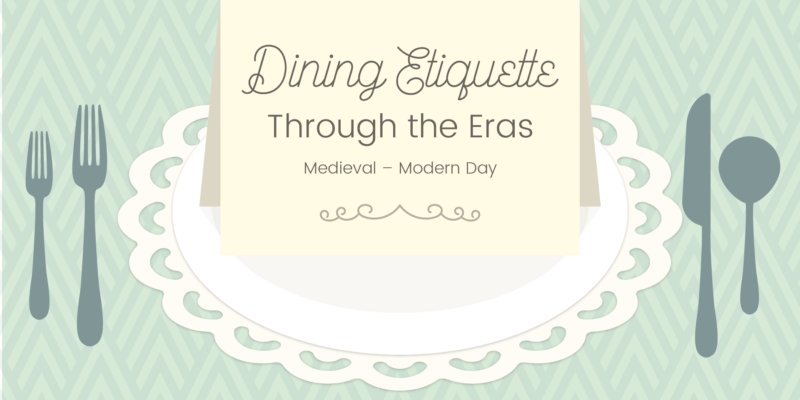Dinner parties are a timelessly popular way to get people together for an evening of good food and fun. With every time period offering their own take, a dinner party conjures lots of different images. From strict formalities and exacting manners at a Victorian occasion to the wild aspic-with-everything menus of the seventies, every era has its quirks!
With many of us looking to rekindle our social lives after the restrictions of the past year, dinner parties are back. With a select guestlist and the comfort of your own home, they are the perfect way to ease you back into face-to-face socialising. To celebrate their return, we’ve taken a dive into the evolution of dinner parties, dinner etiquette and typical menus through the ages.
Medieval
Medieval banquets were an important affair and a large part of medieval life. Feasts were an occasion to display wealth and power, as well as conduct business deals, enter partnerships, organise marriages and bestow awards. In medieval times, banquets were a serious matter involving a lot of guests. Hosting feasts with impressive food and displaying correct etiquette were key to upward social movement.
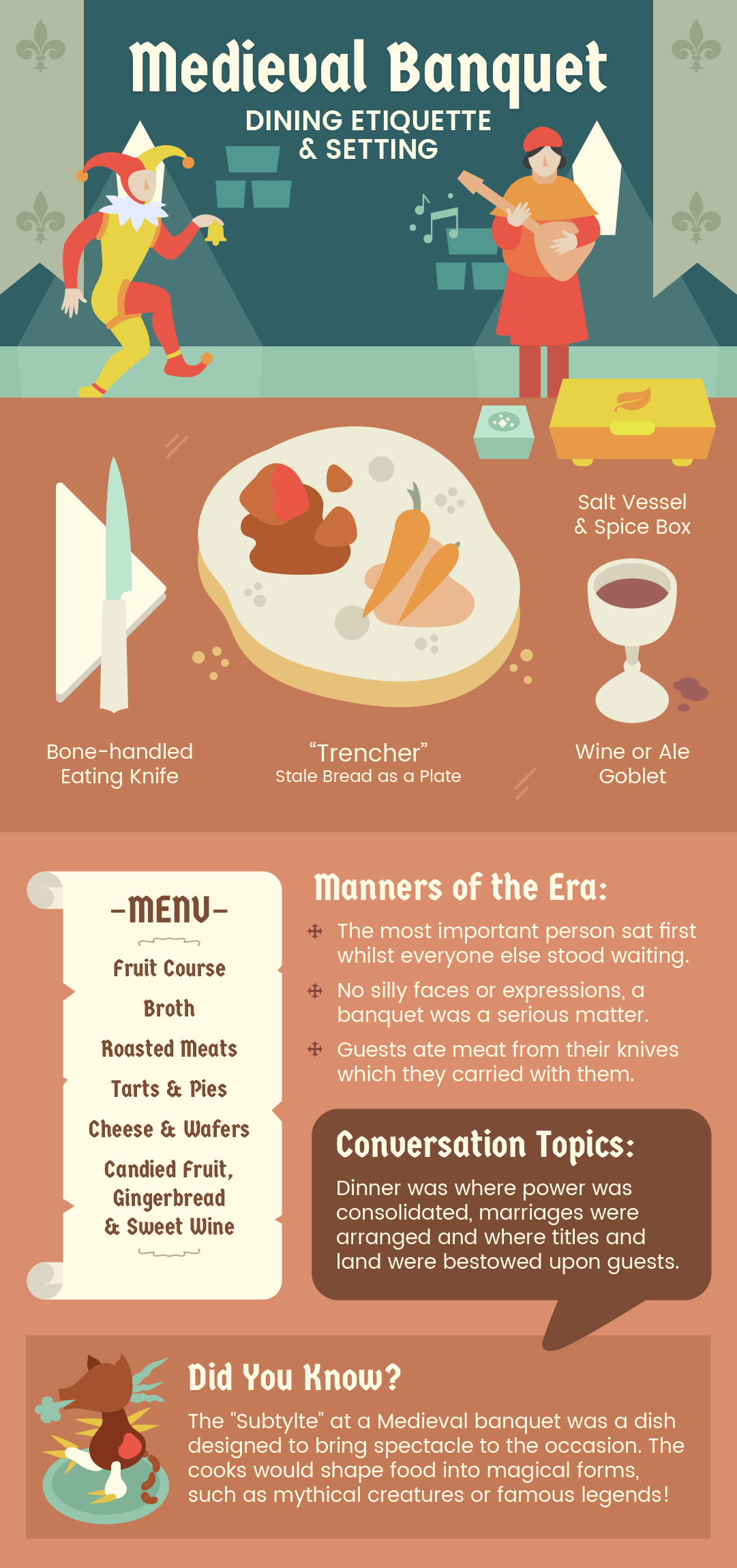
Setting, food & entertainment:
Banquets were often held in a dedicated great hall which would be decorated with tapestries for the occasion. Seating was dictated by status and there would typically be a raised top table for the most important guests. These guests would have their cutlery – a knife, spoon and drinking vessel – laid out for them, but the rest of the guests were expected to bring their own.
Food was used to demonstrate wealth and power and so elaborately displayed dishes and expensive spices in decorative boxes were key to a good banquet. The most impressive elements of medieval banquets were called the ‘subtylte’ which was a dish that was meant to surprise and look spectacular. Cooks would shape food into elaborate designs like castles, fountains and mythical creatures.
Food may have been brought out in a procession with fanfare and music, and entertainment between courses included court jesters, jugglers or musicians.
Etiquette:
The correct dining etiquette was vital at medieval banquets and could help increase or decrease your social standing. Important etiquette included:
- You should stand until the Lord, or most important guest, sat and wait to eat until until the most important person had
- You should wait until the entire course had been served before starting to eat
- Dishes were shared between small groups (known as a ‘mess’) and you should only ever touch the shared food with your left hand
- Food was primarily eaten with your hands – knives were used for cutting and spoons were reserved for soups and broths
- Leftover food was collected and given to the poor – lords and ladies would not expect to eat the same meal twice
- The final ceremony of a feast was a washing of the hands with the Lord going first. On leaving, all guests were expected to bow to the Lord
Victorian
Victorian dinner parties were rather elaborate social occasions filled with formalities and etiquette expectations. Formal dress was expected but the party size was generally kept under 12 to ensure everyone could converse with ease. Throwing a dinner party with numerous courses, lavish table decorations, proper etiquette and light conversation would ensure your guests were impressed and your hosting skills looked upon favourably.
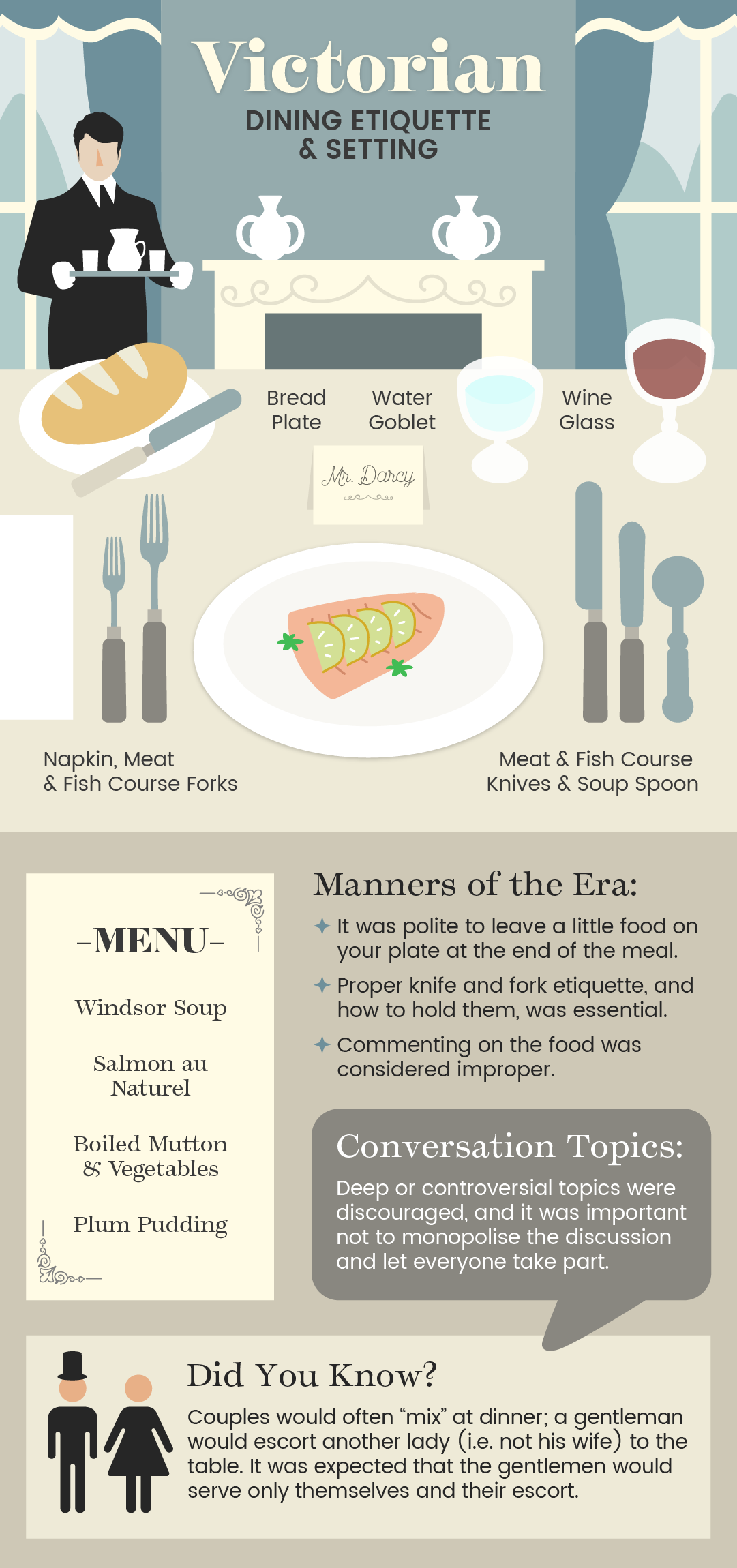
Setting, food & entertainment:
On arrival, guests would be received in the drawing room. The dinner party itself would be held in the dining room, but even the act of going into the dining room was governed by rules. The hostess would organise which gentleman would escort each lady (couples were rarely paired together) and order of entrance into the room was dictated by status. The table setting should be designed to impress with crisp white linens, centrepieces and fine china.
Dinner parties could be quite an elaborate affair for the Victorians, with upwards of 10 courses depending on the occasion and wealth of the hosts. Menus often consisted of soup followed by a fish dish, multiple meat-based main courses and desserts. These could include Vermicelli or Mulligatawny soup, baked salmon, eels, roasted meats like venison, veal, lamb or chicken served with vegetables, and fruits and layered cakes for dessert.
The entertainment at a Victorian dinner party was generally just the conversation. However, after the meal, card games, smoking and drinks might form part of the evening’s entertainment.
Etiquette:
A Victorian dinner party had a lot of etiquette rules to follow, perhaps more than any other age, and great importance was placed on getting these right. Poor etiquette could hamper your social standing and the likelihood of future social invitations. Some rules included:
- Gentlemen would escort a lady to the table and it would be his job to serve her throughout the dinner
- You should remove your gloves at the table
- You should not eat too much or too little, just enough to show your host you enjoyed the meal – too little would be offensive but too much would be vulgar
- You should eat slowly with your mouth closed; you should not make noises when eating or talk with your mouth full
- Holding your cutlery correctly was important, as was using the right cutlery for different foods
- You should not overly comment on the food, including both particular praise or criticism for a dish
- You should not make a scene about anything – whether that’s finding hair in your food or getting into a heated discussion
- Conversation should be kept light – arguing would be bad manners and complex or abstract discussion was thought to impair digestion
- After dinner, guests would retire and be expected to stay around an hour for further socialising – leaving too soon would be rude, as would lingering too long
1920s (Roaring Twenties)
With the economic boom after WW1, the twenties were typified by prosperity, parties and progress. Whilst there was still a strong Victorian era influence, people were keen to shake off the sombre mood of the war and strict Victorian rules. Dinner parties were a bit less formal, food was increasingly influenced by restaurant eating and European flavours, and new design and culture was finding its way into homes.
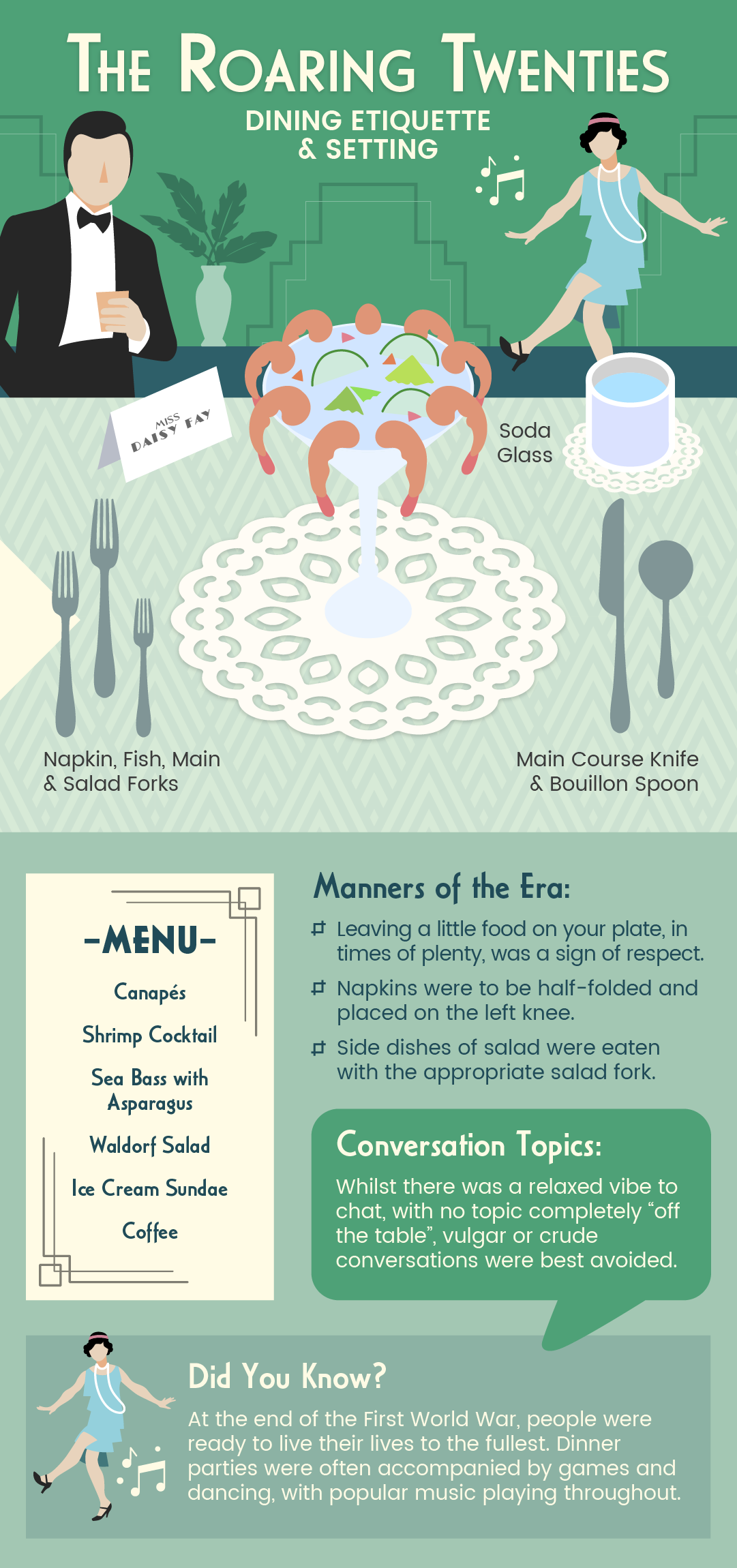
Setting, food & entertainment:
The dinner parties and dining room setup were still quite formal in the 1920s. A beautifully dressed table and proper table settings were expected. However, with increased prosperity and the art deco movement, there was more of a design influence on glassware, tableware and interior decor.
In a step away from formal dinner parties of the past, canapes, hors d’oeuvres and finger food became popular in the twenties. These could be enjoyed with a pre-dinner cocktail whilst standing and mingling with other guests before the main dinner began. Lighter foods and salads also became popular during this era, with more of a focus on vegetables and European cooking.
Entertainment became more of a feature for the twenties dinner party to amuse your guests and keep them talking about your event afterwards. You might enjoy lawn games before dinner, popular music played throughout the evening, and dancing after your meal.
Etiquette:
Twenties dinner party etiquette was largely influenced by your social circle. Older generations would likely still expect all the courtesies of the Victorian age, whereas bright young things were keen to shake off formalities for a more relaxed affair. Typical rules could include:
- The hostess will inform you on whether the dinner is formal or informal and you must dress accordingly
- You should maintain a good posture and shouldn’t put your elbows on the table
- It is acceptable to leave some food on your plate as the hardship of the war is over
- You should lay your napkin on your lap and only put it on the table folded if you aren’t finished eating
- Proper use and holding of cutlery is expected – you should not mash food and you should place cutlery down when you aren’t using it
- You should say farewell to both the host and hostess on leaving but after the party, it is only necessary to thank the hostess
1950s (Post-War)
The post-war era was a frugal time with rationing continuing up to 1954. However, there was a desire to rebuild and for self-betterment, along with the advancement of technology which brought hundreds of new home appliances and kitchen gizmos. Dinner parties of the fifties often had a pretty basic menu but they were all about keeping up appearances and showing your aspirations.
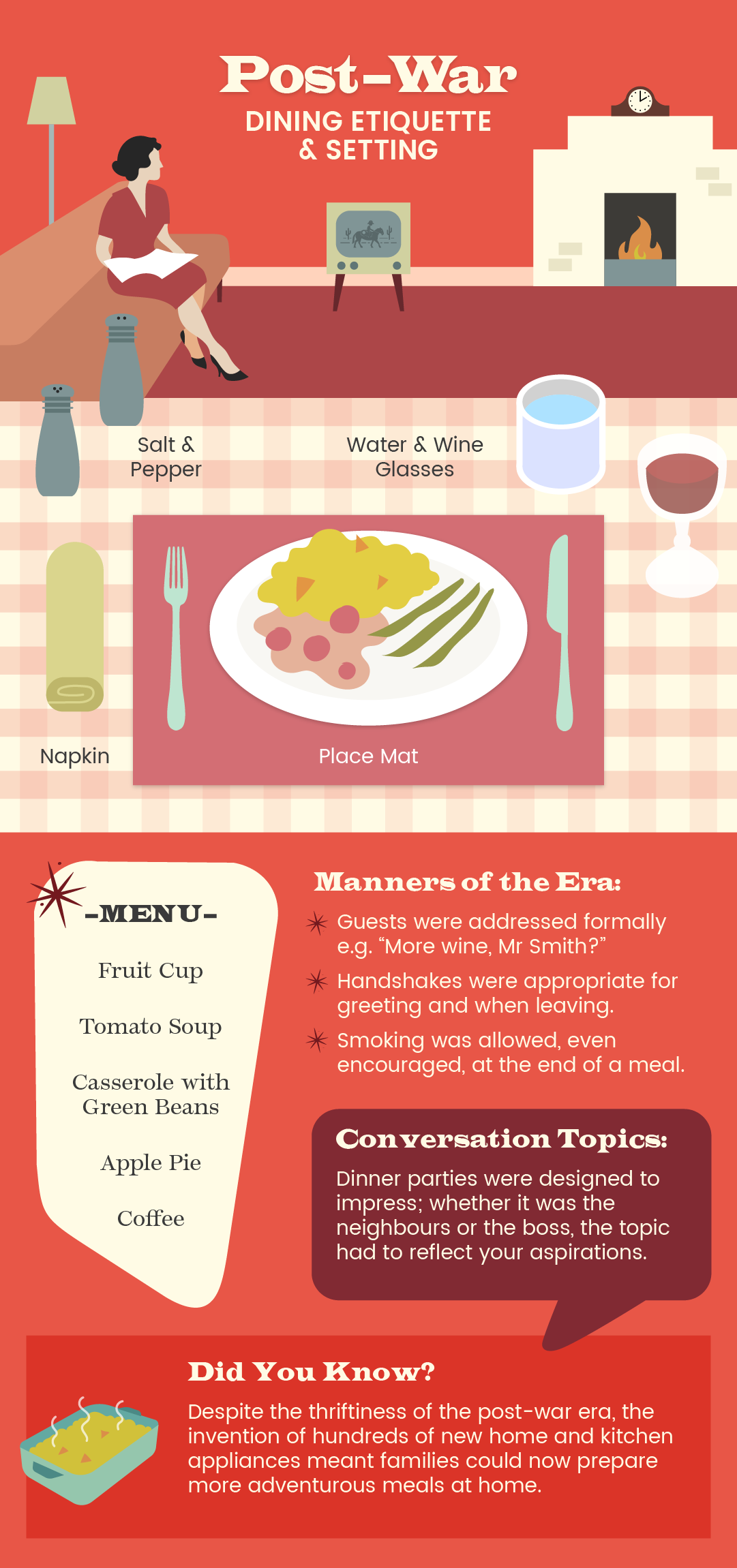
Setting, food & entertainment:
Dinner parties of the fifties were more of a homely affair than in previous eras. Due to the thrift of the post-war era, hired help was a lot less common. Traditional gender roles were still entrenched though and so the woman was expected to play the role of cook, waitress and hostess. Although dinner was still a fairly formal occasion, a lot of the extravagance was dropped. The dining room felt more a part of the home and you might expect patterned tablecloths and place mats to adorn the table.
Food of the fifties was quite traditional and low-brow compared to what we’re used to nowadays, especially with rationing still fresh in mind. A simple 3 course meal would be sufficient, even when entertaining guests. Tinned food was very popular – from spam to fruit cocktail – and roasts, casseroles and stews were still a staple for the main course. Fruit cake or pies would be a common dessert – a pineapple upside down cake would go down a treat.
There wasn’t a lot of focus on dinner party entertainment in the post-war era. However, you may have had the wireless on quietly in the background during dinner and engaged in a few games, drinks and smoking after dinner.
Etiquette:
Some of the pre-twenties formality crept back into the dinner parties of the fifties. As a frugal time, dinner parties were rarer and reserved for special occasions or to impress your guests – whether that was new neighbours, your new boss or the in-laws. Expected etiquette included:
- Dinner parties were a formal occasion and so formal wear was still expected even in the home, including suits for men and cocktail dresses for women
- Handshakes were expected as a greeting and a farewell
- Guests should arrive on time and happily take part in any planned games or activities
- The fifties were the first time children might be allowed at the table but they should remain quiet, well-behaved and speak only when spoken to
- If a guest takes seconds, it is sociable to also take a small amount to keep him company when eating
- If your guests aren’t close friends, you should refer to them formally by title, for example ‘Mr Smith’
1970s (Funky Seventies)
The seventies was a wild time for dinner parties and their menus! Although some critics call the seventies ‘the decade that taste forgot’, there’s no denying a seventies dinner party must have been an entertaining event. Experimental flavours, funky design and more progressive values all had an influence on the era’s dinner parties.
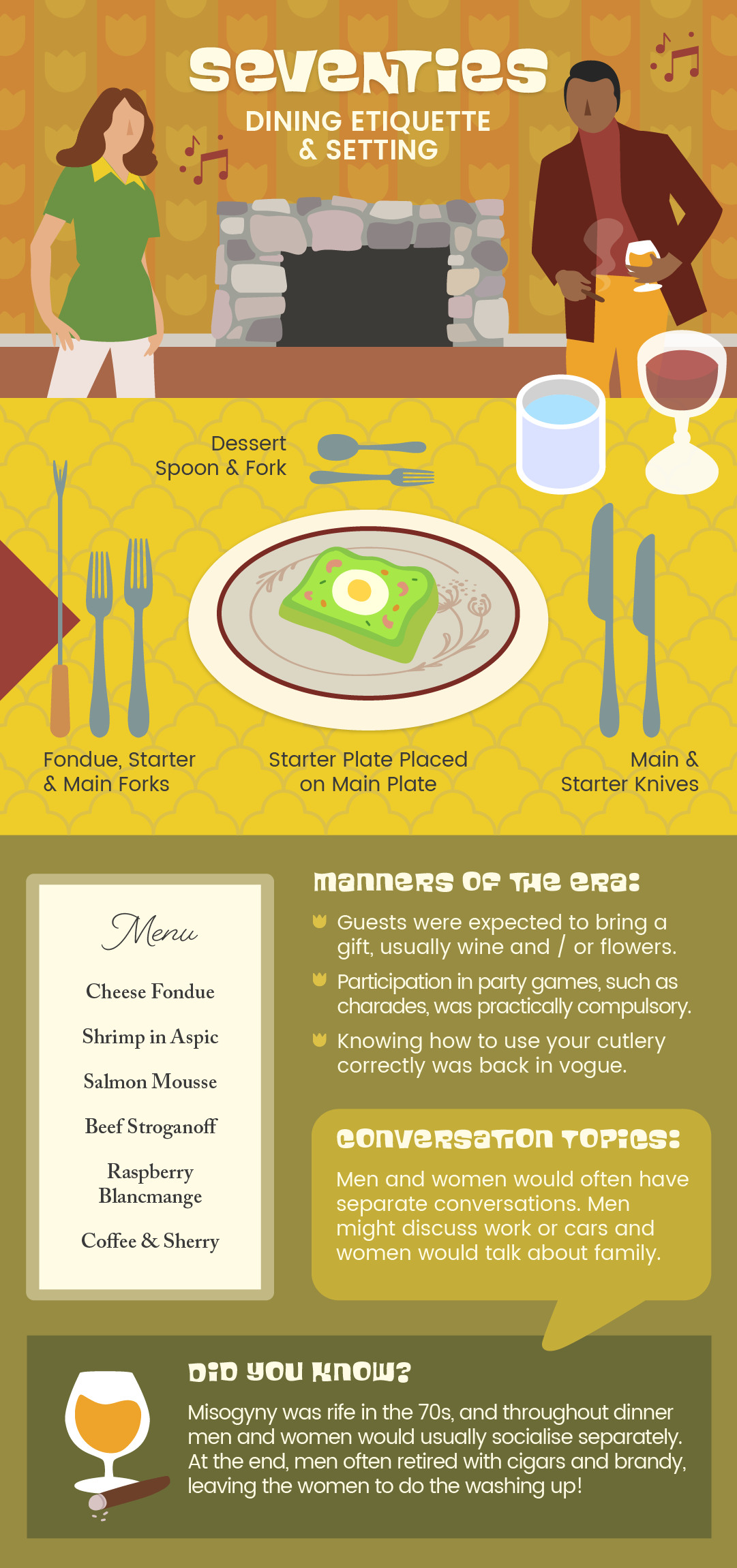
Setting, food & entertainment:
The table setting for a seventies dinner party was often quite formal, even if the overall evening was more relaxed than all other eras. A full set of shiny silverware and matching tableware sets would be common. Entertaining and dinner parties were back in vogue and so fun kitchenware like fondue sets and stylish serving platters were all the rage.
Seventies food was a bit experimental, a bit weird and often very visual. Even though progressive, liberal values were becoming more widespread, it was nearly always the woman of the house who did the cooking. For more elaborate dinner parties, the menu may have included nibbles, a starter, a fish course, meat course and dessert. Nibbles and starters could include vol-au-vents, cheese and pineapple sticks, prawn cocktail and notorious aspic ‘salads’ – food suspended in a savoury jelly. Main courses might include salmon mousse, cheese fondue, beef stroganoff or duck a l’orange. Popular desserts were lemon meringue pie, black forest gateau, rum baba or baked alaska.
Entertainment played a big part in a seventies dinner party. Popular music would be played throughout the evening and party games were often involved. After dinner, you would move to the living room for drinks and cocktails, cigars and maybe some After Eights. After a couple of drinks, there might be some dancing. If you had a particularly stylish and wealthy host, you might get to enjoy chatting in a conversation pit.
Etiquette:
A seventies dinner party was much more relaxed when it came to etiquette. Although you would still want to be a good host and a polite guest, there was much less of a focus on rules and formalities. Good etiquette to follow could still include:
- You should bring your host a gift such as wine or flowers
- The host will give you a written invitation and let you know the appropriate dress code – suits and long dresses were good for formal dinners whereas flares, psychedelic prints and long hippy skirts were good for informal dinners
- During dinner, the TV set should remain off and you would ignore interruptions from the phone ringing
- A dinner party was generally a whole evening affair and guests would be expected to linger after the meal for drinks, games and chat
Modern Day
Here we are at modern day! Dining has gotten a lot more casual and international foods are a normal part of the modern diet. Formal dining is rare and usually reserved for restaurants, but we still love to host friends and family in a much more relaxed setting.
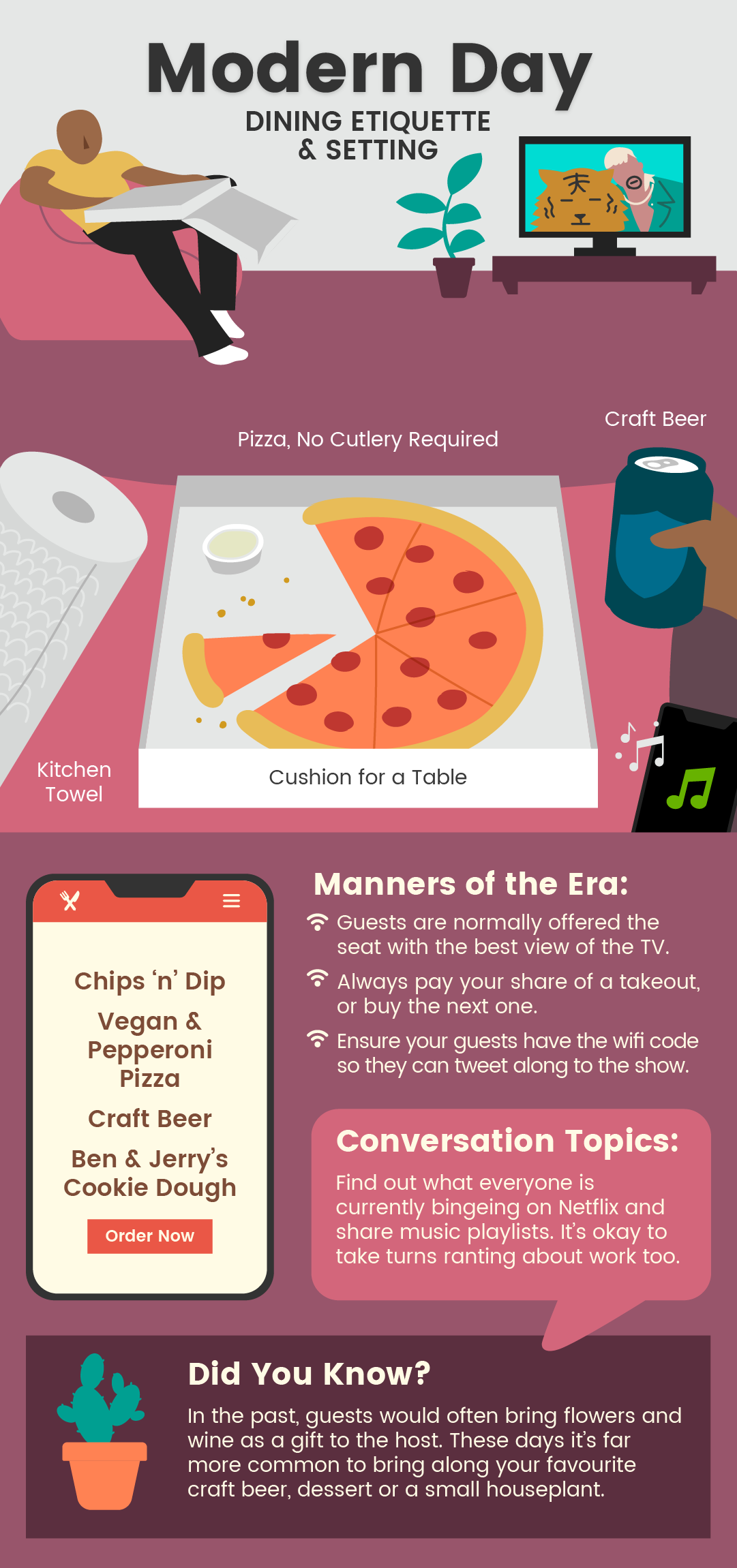
Setting, food & entertainment:
Long gone are the days where dinner parties necessitated a dining room and table. Hosting your friends for dinner could mean a sit down dinner, but nowadays some might not even have a dining room or dining table. With the rise of TV dinners in past decades, eating on the sofa is perfectly acceptable for a relaxed evening with a few friends. For larger parties, BBQs are a very popular option along with al fresco dining.
In an age of globalisation and convenience, there are no limits to the type of food you might have. From classic pasta dishes to curries and noodles, the menu possibilities are vast and often dictated by your host’s tastes as well as their knowledge of guests’ preferences. With the rise of vegetarianism, veganism and awareness of dietary requirements, it’s not uncommon to have multiple options for different guests. Whilst the cooking is much more evenly split between genders than in previous decades, it’s also now common to simply order in food for dinner parties. From takeaways and food delivery services to meal kits, this approach guarantees a good meal and a relaxed evening for the host.
Entertainment is common at modern dinner parties, sometimes being more of the focus of the evening than the food. Eating whilst watching a film for a movie night is popular, as are games nights – whether that’s board games or video games. Staying long after dinner to chat with a couple of glasses of wine or beer is common.
Etiquette:
Formalities and rules have largely gone out the window for modern dinner parties. Whilst basic good manners are expected, it’s much more about being courteous rather than the worry that holding your fork wrong will hurt your social standing! Some basic etiquette may still include:
- You could bring your host a little gift, this might be a houseplant or a bottle of wine
- Guests commonly ask the host if there is anything they can bring to contribute to the dinner party, for example a couple of ingredients or a dessert
- If you will be drinking, bringing your own booze is common
- As the host, you should make your guests as comfortable as possible – give them the best seat, your wifi password and first pick of the food
- After dinner, guests often offer to help tidy away the plates or load the dishwasher
- If you order a takeaway, it is common to offer to contribute to the cost
We hope you enjoyed our dinner party journey and that maybe you’ve even found some inspiration for the next time you host!

